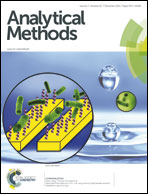Polyacrylamide-protected gold nanoparticles for the determination of manganese ions†
Abstract
A facile and green strategy has been developed for the in situ synthesis of polyacrylamide (PAM)-protected gold nanoparticles (AuNPs). A PAM polymer with thiol-terminated groups was prepared using the reversible addition–fragmentation chain transfer radical polymerization method. The PAM with thiol-terminated groups was able to capture gold ions to form PAM-AuNPs, which displayed a specific response to manganese ions in aqueous solution. The binding forces between the PAM and the manganese ions caused the PAM-AuNPs to move closer together, decreasing the interparticle distance and forming aggregates with a small red shift in the UV-visible absorption band. Dynamic light scattering analysis showed an obviously increased surface charge for the PAM-AuNPs when they were exposed to manganese ions, which could cause cross-linking aggregation. The PAM-AuNPs were used for the determination of manganese ions in the linear range 8.0–500 μmol L−1 with a limit of detection of 5.0 μmol L−1. These aggregates therefore provide a promising assay for the determination of manganese ions in real water samples.


 Please wait while we load your content...
Please wait while we load your content...